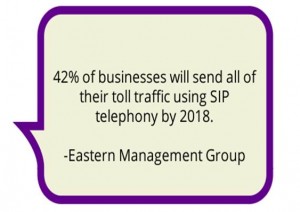
The Growth of SIP Telephony and the Migration to SIP
 SIP Telephony Growth Threatens Toll Network
SIP Telephony Growth Threatens Toll Network
Research from several leading analyst firms confirms that the migration to SIP telephony for business is well underway and will continue it’s rapid expansion over the next several years. According to a SIP study by The Eastern Management Group, 42% of businesses will send all of their toll traffic using SIP telephony by 2018. Infonetics reports that, led by activity in North America, the use of SIP trunking grew 23% in the first half of 2013 vs. the second half of 2012. Several key factors are driving the growing popularity of SIP telephony.
New PBX Systems Support SIP Telephony
The Eastern Management Group report notes that 88% of recently acquired PBX (private branch exchange) solutions support SIP trunking. A SIP-enabled PBX is simply a PBX that can connect to the internet and use the SIP protocol to make calls over the internet. Usually the PBX is IP-based, meaning it connects with endpoints, such as handsets, using Internet Protocol, but this is not a necessity and some traditional digital and analog PBX solutions can be SIP enabled. The only must is that an interface for SIP telephony connectivity is offered.
SIP Telephony Greatly Reduces Toll Costs
Although SIP technology enables a host of unified communications and collaboration capabilities, the main driver for most businesses is economic. SIP telephony represents significant cost savings vs. traditional PRI lines when used for toll bypass. A recent survey by No Jitter revealed that most IT managers identified financial drivers as the main reason for their selection of both the PBX and SIP connectivity. How much money can be saved? According to some experts telecommunications savings of up to 50% are possible, depending on the situation. In addition to the lower cost per concurrent call, the added flexibility of SIP telephony is also attractive. Some SIP providers allow clients to add or cancel channels at any time, making it easier to keep the system’s capacity, and cost, in line with the real-time needs of the business.
Multiple Location Management Simplified with SIP Telephony
Businesses with multiple locations are among those that can benefit most by the use of SIP telephony. The cost savings is multiplied. Calls can be managed centrally by a single SIP trunk at a main location. This reduces the hassle of dealing with several local carriers to set up and manage phone service. It also minimizes the number of PBX systems and amount of hardware to manage, freeing staff of the attendant maintenance and management.
Given these clear benefits, it is no wonder that SIP telephony is becoming increasingly appealing to businesses of all sizes. In fact, the Infonetics research found that 58% of North American businesses say they will use at least some SIP trunks in 2015. The trend of migration to SIP telephony is so strong that it is leading some to question the long term viability of the toll network. As technology managers become more comfortable that SIP vendors can offer reliable, redundant infrastructures and make quality assurances, even these dramatic growth predictions may be understated.


